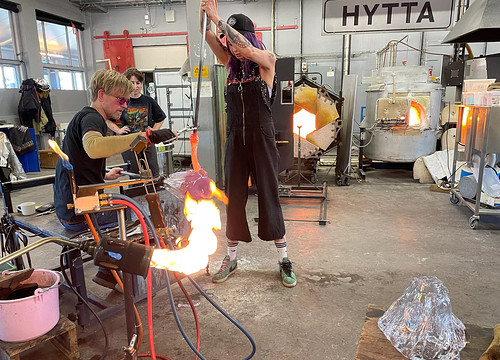Together with Linde Ex and Hendrik Hantschel, Marcel van Kan is teaching the programme of MAPs. He shared his own experience in the field of materials, told us why it is so unique to study materials in Groningen, explained the contradiction of the dialog about materials, and shared how he sees future MAPs students.
“We learn how to work with materials, not just use them”

Can you tell us about your own background and experience with materials?
In the beginning, I was coming from a technical background having studied jewellery making, gold and silversmithing. Working with precious metals, you have to learn how to waste as little as possible with pepper treatment and correct technical drawings. There, I learned that, when listening carefully to materials, they give us instructions on how to deal with them.
Then, I decided to dive deeper into product, jewellery and accessory design at HKU (Utrecht School of the Arts). During my studies, I was focusing on concept development and I discovered that by skillfully manipulating concepts and themes, we can influence and alter the context of our work. At that time I also became aware of the responsibility we bear for both our creations and the remnants of the production process.
Later, I started working with jewellery designer Ted Noten who works in acrylics - actually, a very toxic material, but beautifully transparent to cast items in. It was quite interesting how the artistic statement and the conceptual development were brought together in a conversation piece. It’s good to be in a creative process, but does the work need that specific material? In other words, if materials really had a voice do they want to communicate your ideas? These are also some of the topics that I will really try to address during the MAPs classes.
Why did you decide to come to Groningen and teach MAPs?
For me, Groningen is quite a unique “island” in the Netherlands. It is both dense and wide and presents a lot of possibilities. It has an intense city life: there is Rijksuniversiteit Groningen, interesting stakeholders, a lot of art institutes and galleries, scientists, and culture producers. It also has a unique landscape and micro habitat and many domains of knowledge to learn from, like plants, animals, farmers, fisherman, wind, water that from salty becomes fresh.
Groningen is quite unexplored yet, in my opinion but the dialogue about materials is already open there. For example, local materials such as hemp, potato starch and magnesium play a big role in it. IHOG production is already part of that conversation, and we are planning to collaborate with them.
What is the dialogue about materials? How will MAPs prepare its students for it?
The conversation about materials covers different perspectives and raises thought-provoking questions that are sometimes overlooked.
As creators, we work with materials, but do we even know how they end up in our hands? Let’s take wool as an example. Do we know how to start from scratch, like shaving a sheep, cleaning, carding the wool? It may sound cliché, but because of technology, we sometimes forget the process of how materials are made - the process that teaches us how precious the material is. Even wool is a precious material, but not everyone sees it that way. A lot of it is turned into clothing and then burned because of excessive production. But what other qualities does wool have and thus what other industries can be explored through it?
There are also questions about sustainability and the environment. What does sustainability mean, and how can we achieve it? When we use paint, for instance, do we think about the impact it has? To reduce this impact, maybe we should make a new recipe for paint using local ingredients. Then another interesting question rises: should we start new industries or slow down the existing ones? In the end, almost all things we do cause a footprint. So, really the best way to solve all the problems in this context is not to produce anything anymore. This is quite extreme and also a contradiction, especially for a study of materials. So, do we need materials or do we need to leave them alone? I don't know.
How do you see future MAPs students?
I am looking for explorers and adventurers who are involved in the world of materials. I very much see them as people who are eager to gather knowledge, create their own, and derive from it creating a more contemporary meaning of the use of materials in an artistic practice. I also hope they will document their process and discoveries into a digital material archive.
I see them as people who are passionate about bringing their ideas and artistic practices to life. Or maybe as product designers aspiring to have their own business or already running one. And everyone in between. All of them will make great use of the deeper knowledge of materials, their origins, processes and impact.
Feedback component
How satisfied are you with the information on this page?